Egypt 2015/16 Rice Production: Yield Reduced by Extreme Heat
Summary
USDA estimates 2015/16 Egyptian rice production at 4.0 million tons milled (5.8 million tons rough). Although Egypt planted a record 0.8 million hectares, production was lower than the five-year average of 4.3 million tons milled (6.2 million tons rough) due to poor yields. During August 2015, temperatures were abnormally high, even by Egyptian standards, causing damage to crops, particularly rice. The extreme heat accelerated crop development, reducing grain size and weight. Rough rice yield for 2015/16 is estimated at 7.25 tons per hectare (MT/Ha), a 25-year low, 28 percent below last year’s record 10.10 MT/Ha, and 22 percent below the 5-year average. (Figure 1).
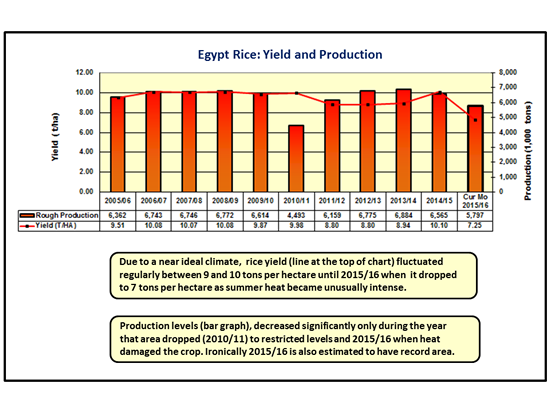
Egyptian Rice Area
In response to changes in the Egyptian cotton program, rice area increased during the 2015/16 season to a record level; 20 percent above the five-year average. Cotton subsidies are typically announced by the Egyptian government prior to sowing in March and April so that farmers can make appropriate planting decisions at the outset. This year, however, announcements were made long after cotton planting had finished so farmers feared there would be either no subsidy or a reduced cotton program, as described in a US agricultural attaché Gain report from Cairo, (Cash Subsidies Removed, Farmers to Contract their Crop before Cultivation; March 30, 2015). Not taking chances with the unknown, farmers planted less area to cotton and increased area planted to rice. The Government of Egypt reversed its earlier decision and instituted the subsidy, as reported in attaché report (After Ten Months of Playing Hardball, Government Backtracks On Its Policy and Will Once Again Subsidize the Cotton Crop). By the time the policy was reversed, cotton planting had been largely avoided and replaced with rice. As a result, 2015/16 rice area was 23 percent above the lower level of the prior year. The reduced acreage planted in 2014/15 was the result of large rice stockpiles, a lack of a procurement price, export bans, and threats to enforce the rice area cap. (Figure 2).

Extreme Heat During 2015
The 2015/16 yield reduction was caused by extremely high temperatures that soared well above normal during summer (Figure 3). Temperatures in the Nile Delta reached 42 °Celsius (108 degrees Fahrenheit) during August on two occasions (Figure 4), and remained above-average continuously from mid-July through September (Figure 5). Overall temperatures averaged about 3.5 °C (6°F) above normal from mid-July through September. Minimum nightly temperatures also remained well above the normal lows from July through September, with two nights staying at or above 32 °C (90°F) (Figure 6). Rice is typically harvested from late August until the middle of September, but this year’s high temperatures accelerated the harvest, which began in early August.
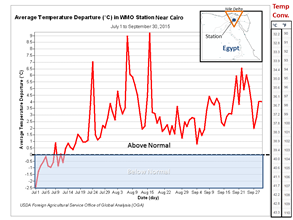 
 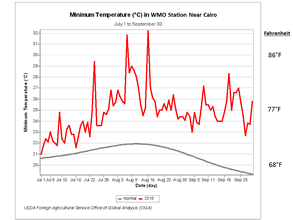
Satellite Imagery
Satellite-derived vegetation indices such as MODIS-NDVI depict reduced vegetation vigor in the Nile Delta during the 2015 summer as being predominantly worse than normal (Figure 7). The more spatially detailed Landsat 8 satellite image also depicts poor vegetative conditions when August 9, 2015 is compared to August 6, 2014 (Figure 8).
The MODIS NDVI time series (Figure 9) depicts low vegetative vigor during the rice growing season as compared to normal. The red line, depicting the 2015 vegetation canopy in the rice growing area, falls below normal in July, never reaching average vigor again for the rest of the season.
 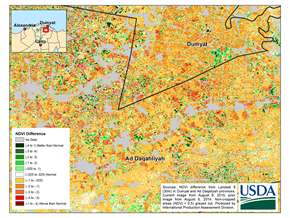
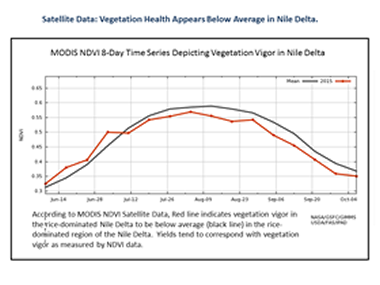
Egyptian Weather, Climate,and Geography
Egypt is extremely arid. The capital city of Cairo, located where the Nile fans out into its delta, averages less than two inches of rainfall a year. With the exception of scattered oases and some new lands that have been reclaimed with pumped well water, Egyptian agriculture is concentrated in a narrow ribbon abutting the Nile River and in the wide, triangular estuary of the Delta. Along the Nile River and the Delta, agriculture is sustained not only from the Nile’s water, but also because of the productive soil of its ancient floodplain. The fertile sub-Saharan soils deposited along the river banks have made agriculture possible in Egypt. (Figure 10)Outside the floodplain, soils are dry, sandy and rocky--unfit for agriculture. The Nile has been a regulated river for over a hundred years because of dams upstream at Aswan. The dams have prevented the cyclical, late-summer seasonal flooding that transported fertile silt deposits downstream each year since antiquity, but they have turned the river into a constant and reliable source of irrigation water, even during the months when the river was typically low.
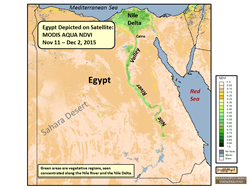 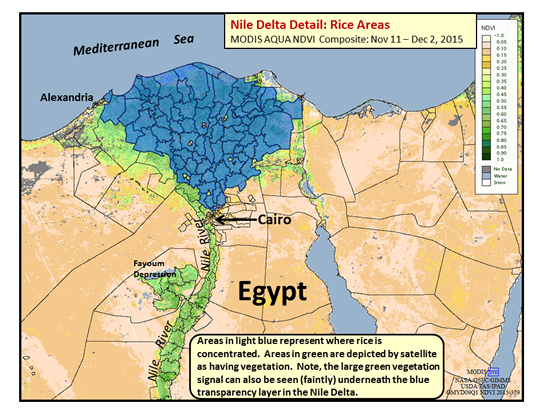
Egypt’s rice crop is constrained to the Nile Delta (Figure 11), which is webbed with a network of canals and channels. Rice farmers utilize the Nile’s water before it empties into the Mediterranean Sea, but after other crops have been irrigated upstream. Most of the rice crop is irrigated with agricultural drainage water and not water directly sourced from the Nile.
Weather is typically not problematic for the irrigated crops of the Nile Delta. Sunny days are the norm, and while Egyptian heat is notorious, heat in the Nile Delta is not known to be as extreme as in nearby areas like the Arabian Peninsula. Under the favorable environment of a stable water supply, constant heat, and ubiquitous sunshine, Egypt’s agriculture produces some of the highest yields in the world. In addition, farms in the Nile Delta are predominantly small in size and use intensive labor practices. Because of favorable weather and a very long growing season, the planting window for rice is wide and the crop grows quickly. Early developing varieties can reach maturity in just three months and yields are typically stable. This year was the rare exception when especially high temperatures decreased rice yield potential.
Agricultural Constraints and Challenges
Some of the challenges to Egyptian agriculture include the fragmentation of farm holdings. Farms are labor intensive and their small size prevents the adoption of modern agricultural methods. Recently there has been increasingly significant encroachment into the limited agricultural areas by expansion of population centers. There are worries about salinity levels increasing in the Nile Delta which would lower rice yield potential. There are also concerns over the construction of a new dam, the Grand Ethiopian Renaissance Dam further upstream. Finally, farming is an aging profession in Egypt with fewer young people interested in making it a career.
This report has been published by the Office of Global Analysis (OGA), International Production Assessment Division (IPAD).
Current USDA area and production estimates for grains and other agricultural commodities are available on IPAD's Agricultural Production page or at PSD Online.
Visit Crop Explorer http://www.pecad.fas.usda.gov/cropexplorer/
|

